The Sinking of the Anglia: 17 November 1917
- Home
- World War I Articles
- The Sinking of the Anglia: 17 November 1917
[This article originally appeared in Gun Fire number 57 and has been lightly edited for website reproduction. All of issues of the Gun Fire magazine are now available to WFA members' via the Member Login. Joining the Western Front Association gives you access not only to the 59 editions of Gun Fire but also to all 110+ issues of the WFA's in house journal Stand To!].
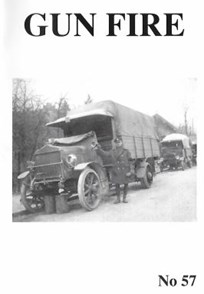
Among the names of the 1/5th King's Own Yorkshire Light Infantry listed in Soldiers Died in the Great War, the deaths of two infantrymen stand out.
Evans, Walter, B. Overseer, Notts, e. Doncaster, 2160, Pte., d., At Sea, 17 /11/15
Turton, Frederick, b. Nottingham, e. Doncaster, 2690, Pte., d., At Sea, 17/11/15
The 1/5th KOYLI only served in France and Flanders so in which sea, or ocean, had they met their deaths? Part of the answer is to be found in Military Operations France and Belgium. [1]
In the midst of these discussions [concerning the reduction of French participation in the Somme offensive] came news of the Battle of Jutland (31st May), which, from the Army's point of view, merely left the Navy, as before, in command of the sea. Of this truth soldiers of all ranks in France had the clearest proof: they had crossed the Channel on their first journey to the theatre of war in crowded transports, and recrossed it in the still more crowded leave boats, or in hospital ships, untroubled by the sight or sign of German vessels of war ...
A footnote, however, pointed out that 'On 17th November 1915 the hospital ship, Anglia, had struck a mine off Dover.' A fuller explanation of the event which brought about the deaths of Evans and Turton, can be found in the KOYLI journal The Bugle, Vol 33 No 1 (1935). It carried the following story, reproduced in full.
HEROISM OF NURSES IN HOSPITAL SHIP WHICH WAS MINED. PHOTOGRAPHS RECALL DISASTER IN WHICH K.O.Y.L.I. SUFFERED
Turning out his sea chest a few days ago, Mr. E. Crissup, of Stokes Croft, Bristol, ex-Chief Petty Officer, RN, came across a set of four small photographs, long forgotten. They were taken when the hospital ship Anglia was mined off Folkestone on 17 November 1915. The wounded on board were mainly men of The Yorkshire Light Infantry, and Mr. Crissup has sent the pictures to The Evening Post, in the belief that they will prove of interest to Yorkshire people.
Is there any reader of The Evening Post who was saved from the Anglia and can supplement the narrative? Is anything known of the identity of the six nurses who, determined to stay by the cot cases to the last, went down with the ship?
Here is the tale as told by Mr. Crissup, who was serving on H.M. Torpedo Boat No 4, when the vessel saved 170 men of The Yorkshire Light Infantry.
To the Editor of "The Yorkshire Evening Post."
Sir, First, I ought to give you the history of these photographs. They were taken by an officer of one of the other rescuing ships, and about one dozen sets were sent to my Commanding Officer, to be issued to the men, according to the assistance given.
My set was lost for 16 years - at least I never even gave them a thought until I found them again the other day.
I was coxswain of H.M. Torpedo Boat No. 4 attached to the Dover Patrol, on the day the Anglia hove in sight. We were about five miles east of Folkestone. The Anglia was returning home with wounded from France. As she approached and passed us, our crew waved and cheered the Tommies and nurses crowding the Anglia's decks. A few minutes later we heard a terrific explosion. Two miles away we could see the Anglia settling down in the water after having struck a mine.
Siren Jammed 'On'.
At that time we were not sure whether she had been mined or torpedoed, but later we learned that the explosion was causd [sic] by a mine. It was perhaps as well for us because if the Anglia had been torpedoed a submarine lurking in the vicinity might have hampered rescue operations.
Our helm was put hard over, and engines at full speed. While racing to the scene of the disaster, we seized upon every object that would float and support human beings, with the idea of throwing these things overboard at the scene of the disaster.
As we approached the stricken ship we could see men jumping over board. When the torpedo boat got alongside, it was difficult to make our orders understood, for a strange reason. The Anglia's siren was blowing the whole time. In the confusion that followed the explosion the siren cord had been pulled too hard, so that it jammed. To make matters worse, we dare not pass our wires or hawsers to secure the torpedo boat to the sinking ship because she would have dragged us to the bottom. We therefore did the best we could in the circumstances.
Though it was extremely difficult to get wounded soldiers aboard T.B. 4, we saved 170 of them. Some were able to cling to buoyant objects we threw into the water. It was a terrible sight. So many of those men could only partially help themselves.
While rescue work was in progress the Captain of T.B. 4 received news that our boat had been holed, and that water was pouring into the war head magazine. This disturbing news was treated with the utmost secrecy. We breathed not a word of this to the wounded soldiers we had rescued - not until the danger was over.
Our engineers worked feverishly to keep the water under control, and they managed to do so.
Meanwhile, other vessels appeared at the scene of the disaster. We still stood by while the Anglia was sinking.
Nurse's Sacrifice
I was able to watch the work of six nurses aboard the sinking ship. They were carrying helpless soldiers - the cot cases, from down below to the upper deck. It was splendid work - the cool way in which they went on helping the wounded while the ship was going down.
We shouted to them to think of their own lives, and ordered them to jump over the stern of the Anglia.
They refused to desert the cot cases.
We dropped astern in the hope that they would jump, and that we should pick them up as they drifted towards us. We waited until the Anglia took the final plunge. Though we searched carefully, we saw no trace of those heroic nurses.
In the meantime we had sent an SOS message to Dover for doctors and nurses to be ready to receive the wounded. Other vessels were still searching among the wreckage as we set off for port. On the way I asked the captain's permission to issue rum and hot drinks to the wounded, and we made everybody as comfortable as possible.
While issuing the rum I noticed the greater number of the wounded soldiers we had taken aboard were men of The Yorkshire Light Infantry. We landed the wounded at Dover, where our torpedo boat, after being "patched," proceeded back to patrol duties.
It may interest survivors of the Anglia disaster to know that T.B. 4 was afterwards blown up off the East Coast. Seven of her crew who helped to rescue men from the Anglia were killed. But T.B. 4 was salvaged and finished her career at Devon port, her home port.
Yours, etc., E. CRISSUP
School House, North Street School, Stokes Croft, Bristol.
[END OF REPRODUCED ARTICLE]
On the day following the sinking the Times carried the story of the disaster and quoted a statement from the War Office which gave the total numbers on board as-13 Officers and 372 Other Ranks, of whom about 300 were saved by patrol vessels. (These numbers did not include doctors, nurses or the ship's crew.) In the same edition the paper's correspondent in Dover said that, as the Anglia was about to plunge to the bottom the propeller was so high that one rescue vessel was able to pass under her stern, thus enabling 40 men to drop on to her, of these two died before reaching the shore'. (Could these have been Evans and Turner?) This desperate and exceedingly dangerous manoeuvre by the un-named vessel must have required the highest standards of seamanship. The Anglia, a steel hulled, twin screwed vessel of 1862 tons launched in 1900 was much bigger than the boats which had rushed to the rescue, and its movements at this particular moment must have been entirely unpredictable.
Once she had settled the two masts of the Anglia, one still carrying the hospital flag, were clearly visible to those who had gathered on the shore during the afternoon. The Times naval correspondent pointed out that this was the first hospital ship to be sunk whilst carrying wounded since the war began. (The Rohilla had been sunk off Whitby on 30 October, 1914, but it did not have wounded on board.) The Times also reported that the collier Lusitania, en route to Lisbon, had lowered two boats to pick up survivors but, shortly after they had left her side, struck a mine and sank. (The collier is referred to in the Bugle as 'the Lousitania of London.')
In addition to quoting from the Times the Bugle's article used a Yorkshire source.
The Yorkshire Post of November 18th, 1915, published an account of the [Anglia] disaster; but at that time full details of such happenings were not often disclosed because of the censorship.
The report stated, however, that the loss of the lives 85 wounded or otherwise invalided soldiers was deeply lamented.
The report continues:-
" It is probable that many of these would have been rescued, but a vessel which went to their assistance encountered another mine, and herself went to the bottom. In regard to the latter vessel the Press Association's correspondent at a channel port says that a collier which sighted the blowing up of the Anglia at once lowered two boats, but just after they had left the men on them noticed their own ship blown up, and they were unable to save the remainder of their crew, who altogether numbered about 28. It was later reported that they had all been picked up by other vessels.
Masts seen from the Shore
"Torpedo boats steamed to the scene and brought some of the rescued to port. Those saved included the matron and two nurses. There were many cot cases on board. Yesterday afternoon the masts of the Anglia, with the hospital flag still flying, were still visible from the shore. The crew of the collier, the Lousitania of London, were also landed ....
At an inquest some days after the loss of the Anglia, Captain Manning said that there were on board nearly 500 persons, including 160 cot cases and 200 walking cases. The explosion took place forward of the bridge on the port side. He was on the bridge, which was blown to smithereens, and he was thrown to the lower deck. He ran to the wireless to send out the SOS signal but met the operator with his face covered with blood, the instruments having been destroyed."
Captain Manning assisted to get a boat clear full of people. The vessel had a heavy list and was down by the head in a sinking condition. He was picked up from the sea unconscious.
[END OF BUGLE ARTICLE]
The War Illustrated regularly devoted a page to 'OUR DIARY OF THE WAR' and on 11 December 1915 it carried an entry about Capt Manning's ship.
Hospital ship Anglia struck a mine in the channel and sank; four officers, one nurse and one hundred and twenty-nine men missing.
No other references to the Anglia appeared in the WI between the disaster and the publication of the diary entry, but the Illustrated London News of 27 November gave it considerable space. Three pages of drawings were devoted to the November incident in the channel and the first was titled '"WOUNDED FIRST!" THE HEROIC NURSES OF THE "ANGLIA".' and the caption contained some well-deserved testimonies from soldier survivors. The nurses"' ... were splendid," was the outspoken tribute of admiration that "They set to work ... to attend to the wounded, helping them into life-belts, assisting to bring men up, from below, declining to listen to all appeals to take places in the boats, standing by the ship to the very end, when they jumped into the water, taking their chance with the rest of us." Said another ... "They all stuck to the wounded to the last. They were all very brave ladies ... ".'
The second London News drawing took up two pages. The Lusitania was shown sinking on the left of the drawing, and the Anglia was in its death throes with the stern high in the air, the rescue ship under it and men jumping on to it. 'She sank by the head', the caption said, and 'her stern, with the propeller still racing round, was lifted so high out of the water that the patrol-vessel engaged in the work of rescue actually passed beneath it, thus enabling some forty men to drop on to her decks.'
Above it is said that the War Illustrated had a small diary entry about the Anglia in December 1915. Early in the following year, on 15 January, it published a photograph of the sinking. It is quite different from any of those used in The Bugle and was clearly taken before the one showing 'the vessel taking the plunge' in that magazine. Here the ship is well on the way to disappearing but two masts are above the water and a pennant is flying from the stern. Five small boats at least are between the hospital ship and the rescue vessel on the right. The illustrated's caption said the photo depicted
The final plunge of the Anglia, the British hospital ship, which struck a mine in the channel on November 17th, 1915. The heroic nurses remained to the last to help the wounded into the boats, and several of them lost their lives. The grave was marked by the emblem to which they had devoted their lives, for the Red Cross continued to float from the flagship above the water.
Two days after the sinking Lady St Helier, in a letter to the Times written from the Almoner's Office, County of London War Hospital, Epsom, asked for assistance for some of the survivors who had lost everything. She said 'A large number of these soldiers are London, Surrey and Middlesex men.' (Where were the 170 wounded KOYLI men taken?) King George sent a message of sympathy to the survivors, and must have counted himself extremely lucky for he had returned from France on board the Anglia on 1 November following a riding accident.[2]
A photograph of seven of the survivors, who had been taken to the County of London War Hospital, appeared in The Great War, edited by H. W. Wilson, together with a drawing of the incident depicting the nurses assisting the wounded above a caption which read, "'Wounded First!" : The Most Beautiful Story Of The War.'[3] Copies of the photographs found by Petty Officer also appeared in The Great War, Vol 6, Page 5, but in neither is there a full description of the sinking.
The Bugle's request for further information about the Anglia disaster, got no response. Soldiers Died records that in an attempt to strangle British supply routes Ludendorff ordered unrestricted submarine warfare to be started on 1 February 1917, even though this would inevitably draw the USA into the war on the side of the Allies.
The next step of the German Government was to announce that it had "conclusive proof that in several instances enemy hospital ships have been misused for the transport of munitions and troops. It has at the same time declared that the traffic of hospital ships ... within a line drawn between Flamborough Head and Terschelling on the one hand, and Ushant to Land's End on the other, will no longer be tolerated".[4]
Previous orders to the German U boats and minelayers had not prevented the sinking of hospital ships prior to this date. WIison and Hammerton listed the names of other hospital ships which were attacked or sunk.[5]
1 February 1915 - Asturias attacked by a submarine off Le Havre
30 March 1916 - Portugal Franco-Russian hospital ship allegedly sunk by torpedo off the coast of Anatolia.
21 November 1916 - Britannic 48000 ton was sunk in the Aegean Sea with the loss of 60 lives
24 December 1916 - Braemar Castle also sunk in the Aegean Sea
20 March 1917 - Asturias carrying 900 wounded was sunk, allegedly by torpedo, in the Channel with the loss of 31 lives.
30 March 1917 - Gloucester Castle allegedly torpedoed in the Channel. No lives were lost.
10 April 1917 - Salta hospital ship sunk in the Channel by a mine. No wounded were on board but 38 nurses and sisters of the RAMC were drowned.
17 April 1917 - Lanfranc hospital ship attacked by a submarine and sunk in the Channel. It was carrying British wounded and German prisoners. Of the 34 who lost their lives 15 were German prisoners.
17 April 1917 - Donegal attacked on the same night as the Lanfranc with the loss of 41 lives.
Two more ships were sunk in May 1917 which are not included in the above list. Doubtless it fails to include all British hospital ships sunk by enemy action. Throughout the war nearly 100 were engaged in transporting sick and wounded, and, on occasion, enemy prisoners. Three famous liners, the Aquitania, Mauritania and Britannic were used for the longer journeys; the Aquitania alone being capable of carrying 5,000 patients. The largest cross-Channel ship used was the Asturias which had accommodation for up to 2,700 patients.
Perhaps it might not be to unfair to the editor of the Bugle to say that he gave the impression that the dramatic photographs Mr Crissup found were all there were. He wrote of 'a set' of 'four small' pictures and reproduced three of them.
Various photos are reproduced below
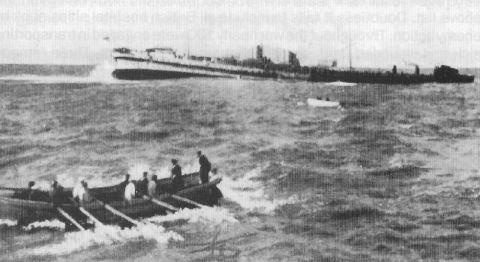
The sinking of the Anglia' with the hospital ship 'settling' down by the bows. H. M. Torpedo Boat No. 4 close at hand. - It has two funnels and its bow is just in line with the Anglia's stern
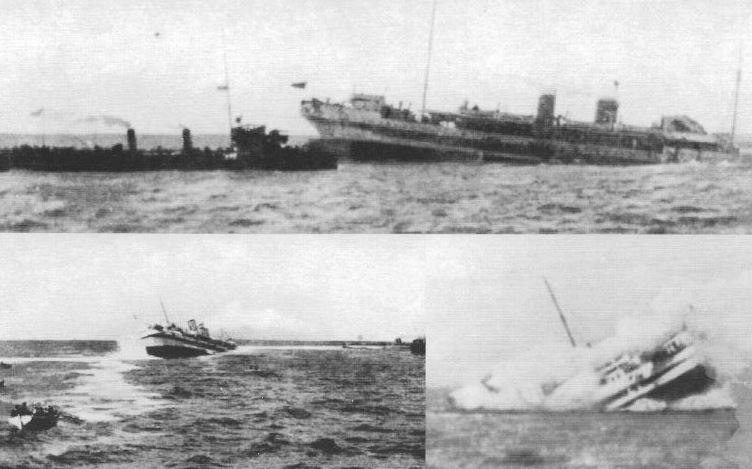
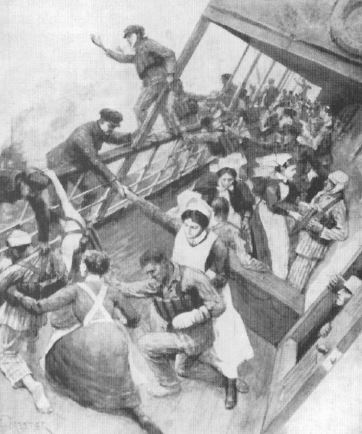
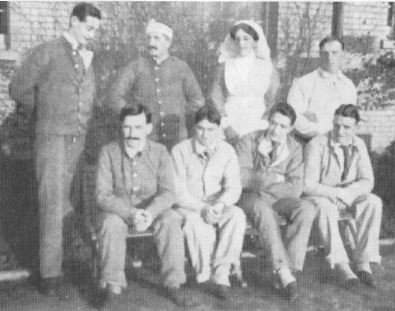
Malcolm K. Johnson
- J. E. Edmonds, Military Operations France and Belgium 1916 Vol 1, (1932) p263
- During an inspection of representatives of the Second Army, 26 October 1915, the King was thrown from his horse.
- H. W. Wilson and J. A. Hammerton (eds), The Great War Vol 5 (1916) p 203
- Ibid Vol 9 op. cit p 27
- Ibid pp 255-5 7.





